2015 KIA Sportage service
[x] Cancel search: servicePage 423 of 499
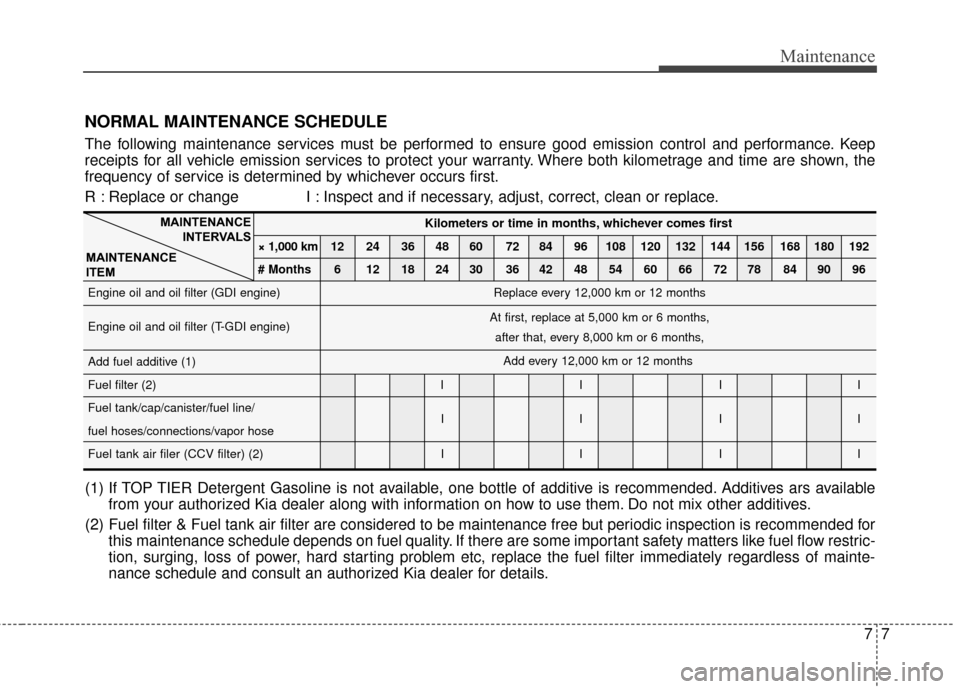
77
Maintenance
Kilometers or time in months, whichever comes first
× 1,000 km 12 24 36 48 60 72 84 96 108 120 132 144 156 168 180 192
# Months 6 12 18 24 30 36 42 48 54 60 66 72 78 84 90 96
Engine oil and oil filter (GDI engine)
Engine oil and oil filter (T-GDI engine)
Add fuel additive (1)
Fuel filter (2) I I I I
Fuel tank/cap/canister/fuel line/ II II
fuel hoses/connections/vapor hose
Fuel tank air filer (CCV filter) (2) II II
MAINTENANCE
INTERVALS
MAINTENANCE
ITEM
Replace every 12,000 km or 12 months
At first, replace at 5,000 km or 6 months, after that, every 8,000 km or 6 months,
Add every 12,000 km or 12 months
(1) If TOP TIER Detergent Gasoline is not available, one bottle of additive is recommended. Additives ars available from your authorized Kia dealer along with information on how to use them. Do not mix other additives.
(2) Fuel filter & Fuel tank air filter are considered to be maintenance free\
but periodic inspection is recommended for this maintenance schedule depends on fuel quality. If there are some important safety matters like fuel flow restric-
tion, surging, loss of power, hard starting problem etc, replace the fuel filter immediately regardless of mainte-
nance schedule and consult an authorized Kia dealer for details.
The following maintenance services must be performed to ensure good emission control and performance. Keep
receipts for all vehicle emission services to protect your warranty. Where both kilometrage and time are shown, the
frequency of service is determined by whichever occurs first.
R : Replace or change I : Inspect and if necessary, adjust, correct, clean or replace.
NORMAL MAINTENANCE SCHEDULE
Page 428 of 499
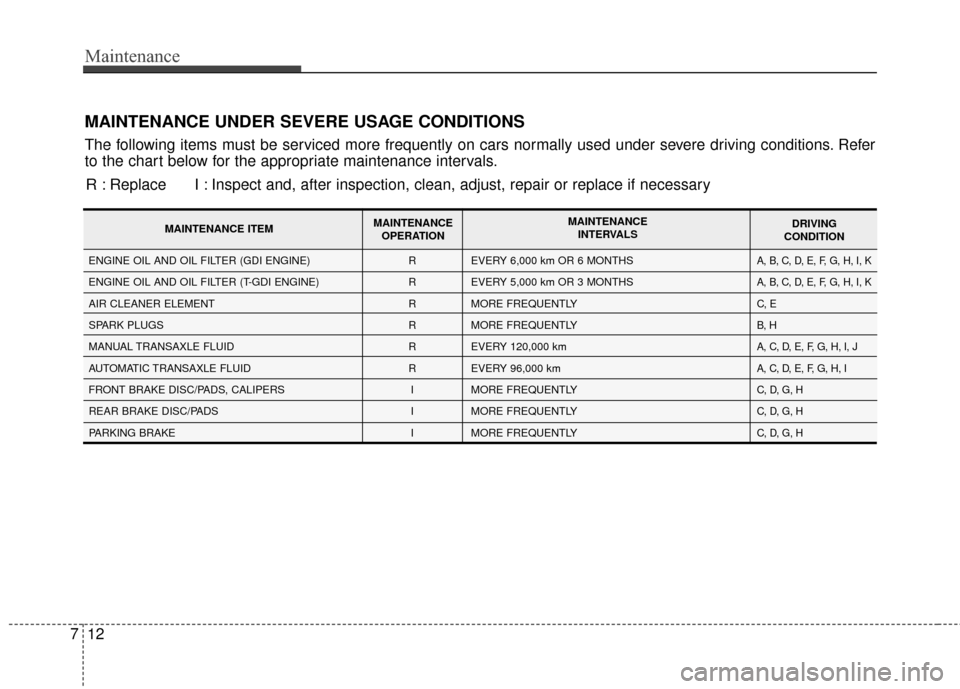
Maintenance
12
7
MAINTENANCE UNDER SEVERE USAGE CONDITIONS
The following items must be serviced more frequently on cars normally used under severe driving conditions. Refer
to the chart below for the appropriate maintenance intervals.
R : Replace I : Inspect and, after inspection, clean, adjust, repair or replace if neces\
sary
R
R
R
R
R
R
I
I
I EVERY 6,000 km OR 6 MONTHS
EVERY 5,000 km OR 3 MONTHS
MORE FREQUENTLY
MORE FREQUENTLY
EVERY 120,000 km
EVERY 96,000 km
MORE FREQUENTLY
MORE FREQUENTLY
MORE FREQUENTLYA, B, C, D, E, F, G, H, I, K
A, B, C, D, E, F, G, H, I, K
C, E
B, H
A, C, D, E, F, G, H, I, J
A, C, D, E, F, G, H, I
C, D, G, H
C, D, G, H
C, D, G, H ENGINE OIL AND OIL FILTER (GDI ENGINE)
ENGINE OIL AND OIL FILTER (T-GDI ENGINE)
AIR CLEANER ELEMENT
SPARK PLUGS
MANUAL TRANSAXLE FLUID
AUTOMATIC TRANSAXLE FLUID
FRONT BRAKE DISC/PADS, CALIPERS
REAR BRAKE DISC/PADS
PARKING BRAKE
MAINTENANCE ITEM MAINTENANCE
OPERATION MAINTENANCE
INTERVALS DRIVING
CONDITION
Page 445 of 499
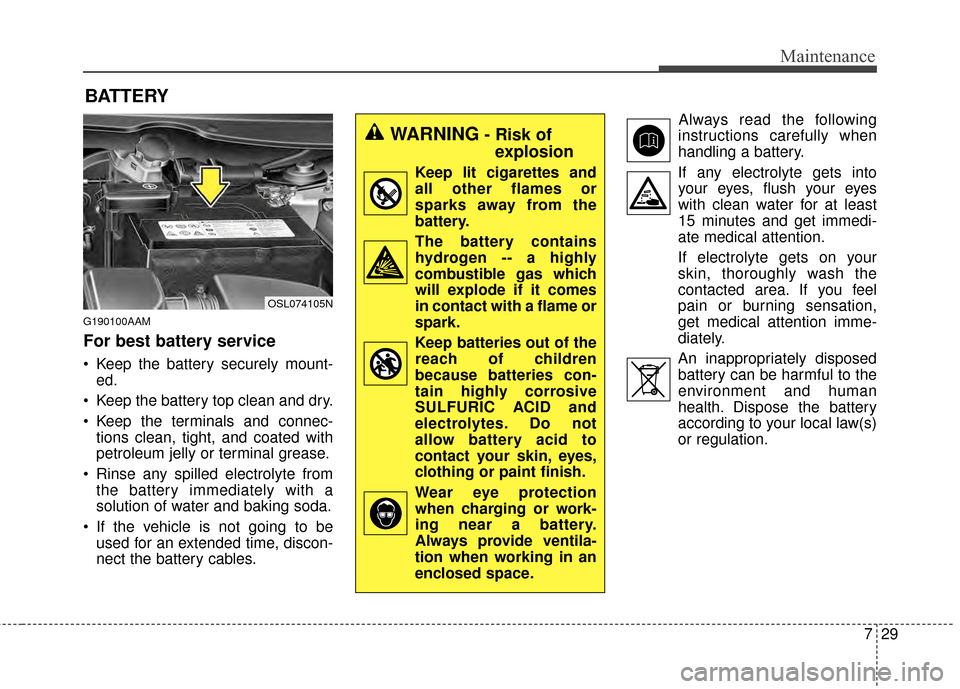
729
Maintenance
BATTERY
G190100AAM
For best battery service
Keep the battery securely mount-ed.
Keep the battery top clean and dry.
Keep the terminals and connec- tions clean, tight, and coated with
petroleum jelly or terminal grease.
Rinse any spilled electrolyte from the battery immediately with a
solution of water and baking soda.
If the vehicle is not going to be used for an extended time, discon-
nect the battery cables. Always read the following
instructions carefully when
handling a battery.
If any electrolyte gets into your eyes, flush your eyes
with clean water for at least
15 minutes and get immedi-
ate medical attention.
If electrolyte gets on your
skin, thoroughly wash the
contacted area. If you feel
pain or burning sensation,
get medical attention imme-
diately.
An inappropriately disposed battery can be harmful to the
environment and human
health. Dispose the battery
according to your local law(s)
or regulation.
OSL074105N
WARNING- Risk of explosion
Keep lit cigarettes and
all other flames or
sparks away from the
battery.
The battery contains hydrogen -- a highly
combustible gas which
will explode if it comes
in contact with a flame or
spark.
Keep batteries out of the reach of children
because batteries con-
tain highly corrosive
SULFURIC ACID and
electrolytes. Do not
allow battery acid to
contact your skin, eyes,
clothing or paint finish.
Wear eye protection when charging or work-
ing near a battery.
Always provide ventila-
tion when working in an
enclosed space.
Page 456 of 499
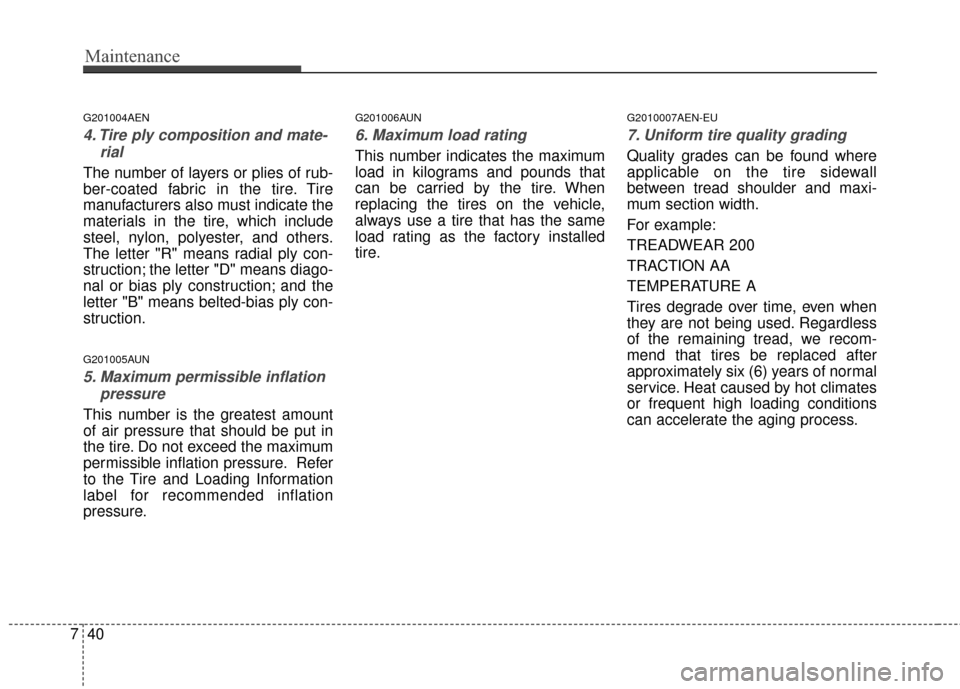
Maintenance
40
7
G201004AEN
4. Tire ply composition and mate-
rial
The number of layers or plies of rub-
ber-coated fabric in the tire. Tire
manufacturers also must indicate the
materials in the tire, which include
steel, nylon, polyester, and others.
The letter "R" means radial ply con-
struction; the letter "D" means diago-
nal or bias ply construction; and the
letter "B" means belted-bias ply con-
struction.
G201005AUN
5. Maximum permissible inflationpressure
This number is the greatest amount
of air pressure that should be put in
the tire. Do not exceed the maximum
permissible inflation pressure. Refer
to the Tire and Loading Information
label for recommended inflation
pressure.
G201006AUN
6. Maximum load rating
This number indicates the maximum
load in kilograms and pounds that
can be carried by the tire. When
replacing the tires on the vehicle,
always use a tire that has the same
load rating as the factory installed
tire.
G2010007AEN-EU
7. Uniform tire quality grading
Quality grades can be found where
applicable on the tire sidewall
between tread shoulder and maxi-
mum section width.
For example:
TREADWEAR 200
TRACTION AA
TEMPERATURE A
Tires degrade over time, even when
they are not being used. Regardless
of the remaining tread, we recom-
mend that tires be replaced after
approximately six (6) years of normal
service. Heat caused by hot climates
or frequent high loading conditions
can accelerate the aging process.
Page 457 of 499
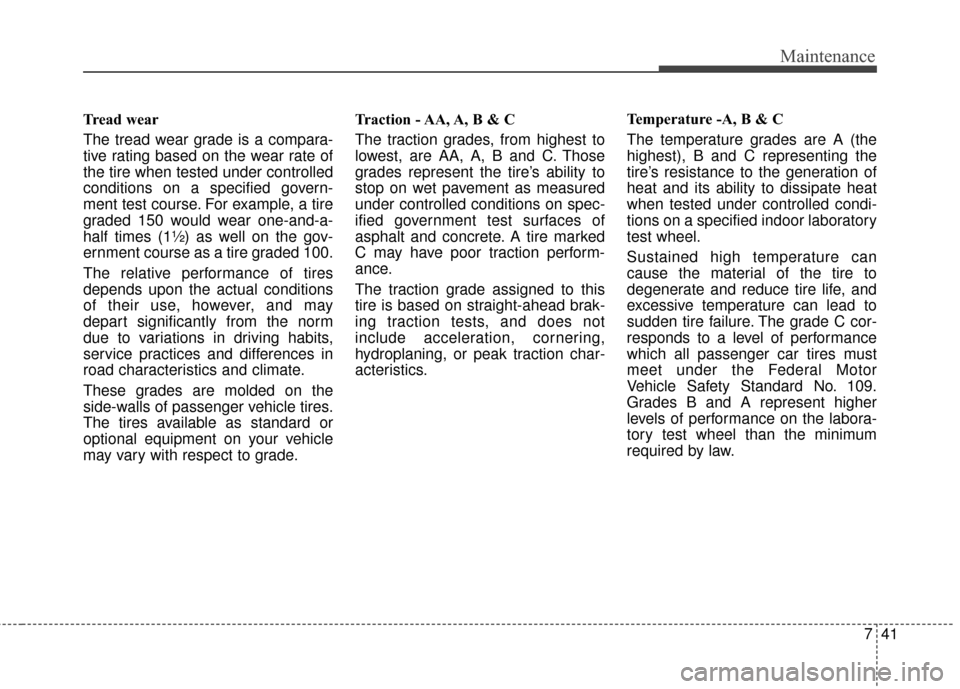
741
Maintenance
Tread wear
The tread wear grade is a compara-
tive rating based on the wear rate of
the tire when tested under controlled
conditions on a specified govern-
ment test course. For example, a tire
graded 150 would wear one-and-a-
half times (1½) as well on the gov-
ernment course as a tire graded 100.
The relative performance of tires
depends upon the actual conditions
of their use, however, and may
depart significantly from the norm
due to variations in driving habits,
service practices and differences in
road characteristics and climate.
These grades are molded on the
side-walls of passenger vehicle tires.
The tires available as standard or
optional equipment on your vehicle
may vary with respect to grade.Traction - AA, A, B & C
The traction grades, from highest to
lowest, are AA, A, B and C. Those
grades represent the tire’s ability to
stop on wet pavement as measured
under controlled conditions on spec-
ified government test surfaces of
asphalt and concrete. A tire marked
C may have poor traction perform-
ance.
The traction grade assigned to this
tire is based on straight-ahead brak-
ing traction tests, and does not
include acceleration, cornering,
hydroplaning, or peak traction char-
acteristics.
Temperature -A, B & C
The temperature grades are A (the
highest), B and C representing the
tire’s resistance to the generation of
heat and its ability to dissipate heat
when tested under controlled condi-
tions on a specified indoor laboratory
test wheel.
Sustained high temperature can
cause the material of the tire to
degenerate and reduce tire life, and
excessive temperature can lead to
sudden tire failure. The grade C cor-
responds to a level of performance
which all passenger car tires must
meet under the Federal Motor
Vehicle Safety Standard No. 109.
Grades B and A represent higher
levels of performance on the labora-
tory test wheel than the minimum
required by law.
Page 488 of 499
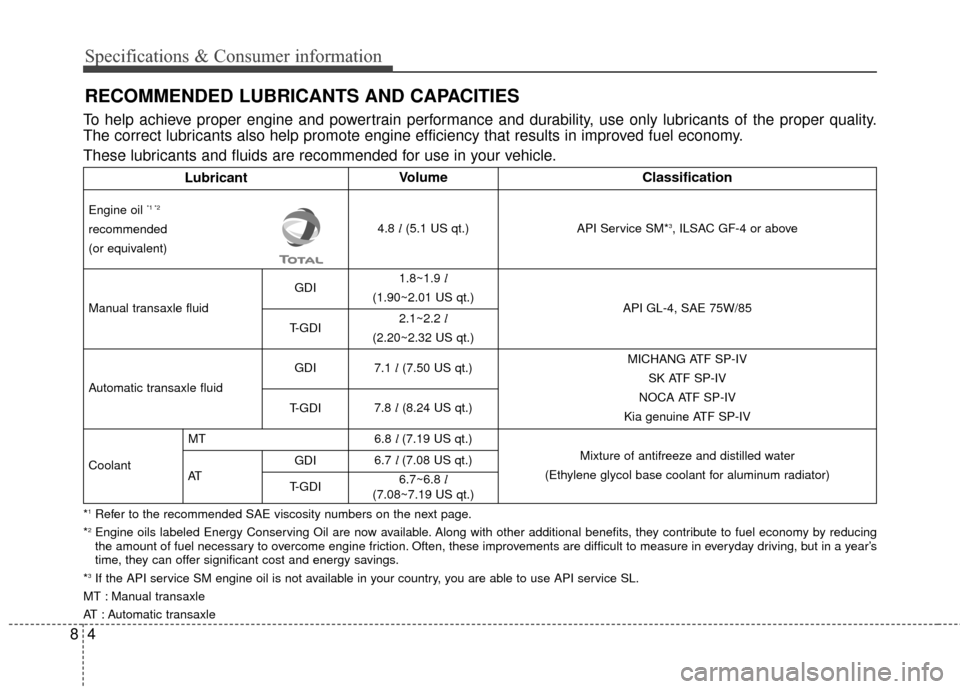
RECOMMENDED LUBRICANTS AND CAPACITIES
8
These lubricants and fluids are recommended for use in your vehicle.
To help achieve proper engine and powertrain performance and durability, use only lubricants of the proper quality.
The correct lubricants also help promote engine efficiency that results in improved fuel economy.
*1Refer to the recommended SAE viscosity numbers on the next page.
*2Engine oils labeled Energy Conserving Oil are now available. Along with other additional benefits, they contribute to fuel economy by reducing
the amount of fuel necessary to overcome engine friction. Often, these improvements are difficult to measure in everyday driving, but in a year’s
time, they can offer significant cost and energy savings.
*
3If the API service SM engine oil is not available in your country, you are able to use API service SL.
MT : Manual transaxle
AT : Automatic transaxle
4
Specifications & Consumer information
LubricantVolumeClassification
Engine oil *1 *2
recommended
(or equivalent)4.8 l(5.1 US qt.)API Service SM*3, ILSAC GF-4 or above
Manual transaxle fluid
GDI1.8~1.9 l
(1.90~2.01 US qt.)
API GL-4, SAE 75W/85
T-GDI2.1~2.2 l
(2.20~2.32 US qt.)
Automatic transaxle fluid
GDI7.1 l(7.50 US qt.)MICHANG ATF SP-IV
SK ATF SP-IV
NOCA ATF SP-IV
Kia genuine ATF SP-IV
T-GDI7.8 l(8.24 US qt.)
Coolant
MT6.8 l (7.19 US qt.)
Mixture of antifreeze and distilled water
(Ethylene glycol base coolant for aluminum radiator)
AT
GDI6.7 l (7.08 US qt.)
T-GDI6.7~6.8 l
(7.08~7.19 US qt.)
Page 497 of 499
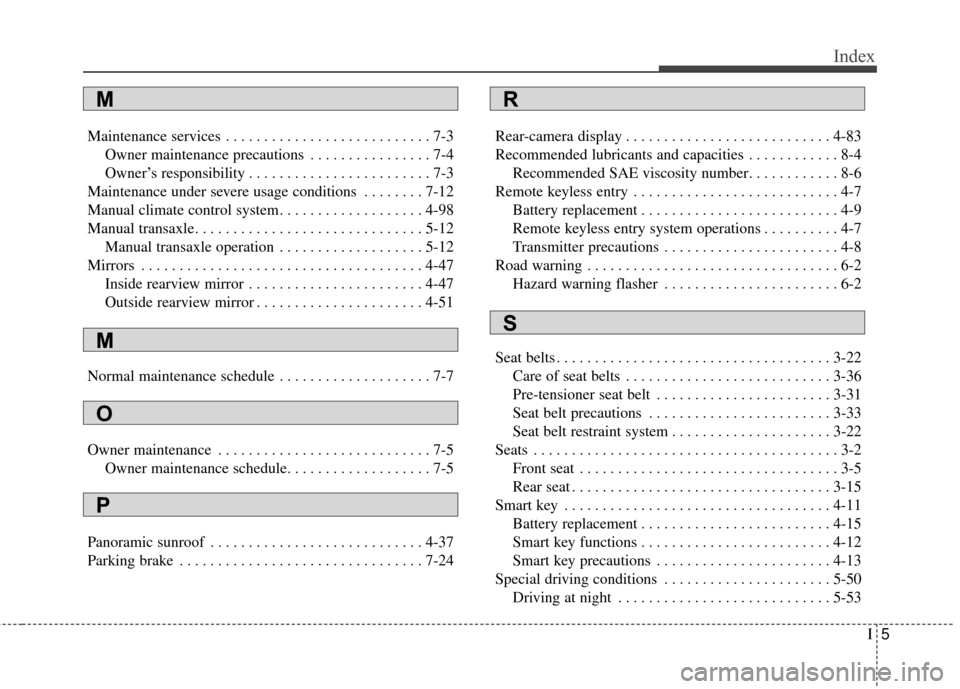
I5
Index
Maintenance services . . . . . . . . . . . . . . . . . . . . . . . . . . . 7-3Owner maintenance precautions . . . . . . . . . . . . . . . . 7-4
Owner’s responsibility . . . . . . . . . . . . . . . . . . . . . . . . 7-3
Maintenance under severe usage conditions . . . . . . . . 7-12
Manual climate control system. . . . . . . . . . . . . . . . . . . 4-98
Manual transaxle. . . . . . . . . . . . . . . . . . . . . . . . . . . . . . 5-12 Manual transaxle operation . . . . . . . . . . . . . . . . . . . 5-12
Mirrors . . . . . . . . . . . . . . . . . . . . . . . . . . . . . . . . . . . . \
. 4-47 Inside rearview mirror . . . . . . . . . . . . . . . . . . . . . . . 4-47
Outside rearview mirror . . . . . . . . . . . . . . . . . . . . . . 4-51
Normal maintenance schedule . . . . . . . . . . . . . . . . . . . . 7-7
Owner maintenance . . . . . . . . . . . . . . . . . . . . . . . . . . . . 7-5 Owner maintenance schedule. . . . . . . . . . . . . . . . . . . 7-5
Panoramic sunroof . . . . . . . . . . . . . . . . . . . . . . . . . . . . 4-37
Parking brake . . . . . . . . . . . . . . . . . . . . . . . . . . . . . . . . 7-24 Rear-camera display . . . . . . . . . . . . . . . . . . . . . . . . . . . 4-83
Recommended lubricants and capacities . . . . . . . . . . . . 8-4
Recommended SAE viscosity number. . . . . . . . . . . . 8-6
Remote keyless entry . . . . . . . . . . . . . . . . . . . . . . . . . . . 4-7 Battery replacement . . . . . . . . . . . . . . . . . . . . . . . . . . 4-9
Remote keyless entry system operations . . . . . . . . . . 4-7
Transmitter precautions . . . . . . . . . . . . . . . . . . . . . . . 4-8
Road warning . . . . . . . . . . . . . . . . . . . . . . . . . . . . . . . . . 6-2 Hazard warning flasher . . . . . . . . . . . . . . . . . . . . . . . 6-2
Seat belts . . . . . . . . . . . . . . . . . . . . . . . . . . . . . . . . . . . . \
3-22 Care of seat belts . . . . . . . . . . . . . . . . . . . . . . . . . . . 3-36
Pre-tensioner seat belt . . . . . . . . . . . . . . . . . . . . . . . 3-31
Seat belt precautions . . . . . . . . . . . . . . . . . . . . . . . . 3-33
Seat belt restraint system . . . . . . . . . . . . . . . . . . . . . 3-22
Seats . . . . . . . . . . . . . . . . . . . . . . . . . . . . . . . . . . . . \
. . . . 3-2 Front seat . . . . . . . . . . . . . . . . . . . . . . . . . . . . . . . . . . 3-5
Rear seat . . . . . . . . . . . . . . . . . . . . . . . . . . . . . . . . . . 3-15\
Smart key . . . . . . . . . . . . . . . . . . . . . . . . . . . . . . . . . . . 4-\
11 Battery replacement . . . . . . . . . . . . . . . . . . . . . . . . . 4-15
Smart key functions . . . . . . . . . . . . . . . . . . . . . . . . . 4-12
Smart key precautions . . . . . . . . . . . . . . . . . . . . . . . 4-13
Special driving conditions . . . . . . . . . . . . . . . . . . . . . . 5-50 Driving at night . . . . . . . . . . . . . . . . . . . . . . . . . . . . 5-53
M
M
R
S
O
P
Page 498 of 499
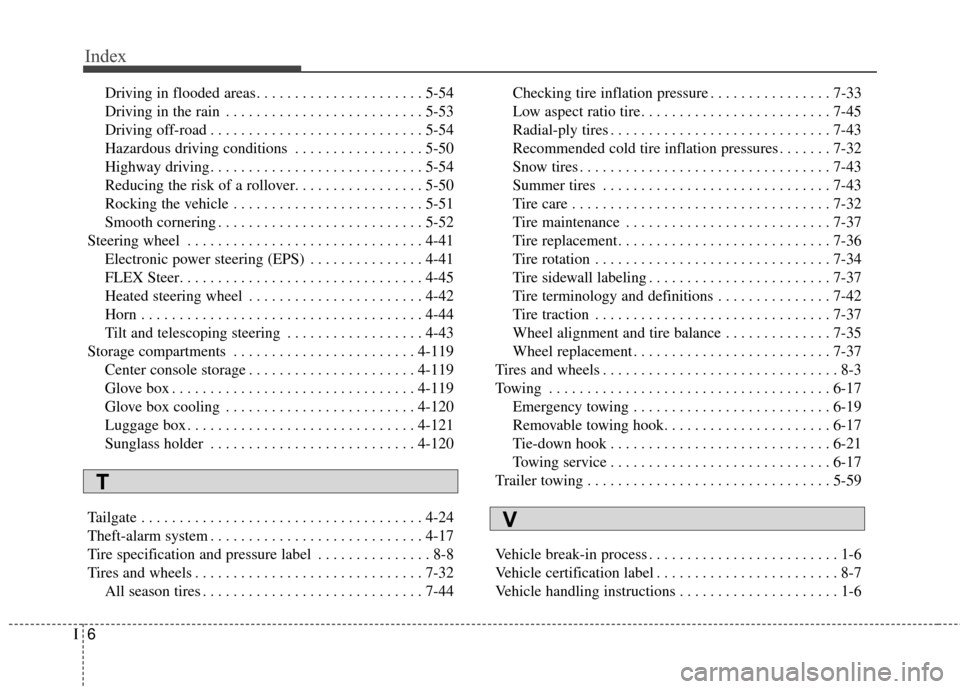
Index
6I
Driving in flooded areas. . . . . . . . . . . . . . . . . . . . . . 5-54
Driving in the rain . . . . . . . . . . . . . . . . . . . . . . . . . . 5-53
Driving off-road . . . . . . . . . . . . . . . . . . . . . . . . . . . . 5-54
Hazardous driving conditions . . . . . . . . . . . . . . . . . 5-50
Highway driving. . . . . . . . . . . . . . . . . . . . . . . . . . . . 5-54
Reducing the risk of a rollover. . . . . . . . . . . . . . . . . 5-50
Rocking the vehicle . . . . . . . . . . . . . . . . . . . . . . . . . 5-51
Smooth cornering . . . . . . . . . . . . . . . . . . . . . . . . . . . 5-52
Steering wheel . . . . . . . . . . . . . . . . . . . . . . . . . . . . . . . 4-41 Electronic power steering (EPS) . . . . . . . . . . . . . . . 4-41
FLEX Steer. . . . . . . . . . . . . . . . . . . . . . . . . . . . . . . . 4-45
Heated steering wheel . . . . . . . . . . . . . . . . . . . . . . . 4-42
Horn . . . . . . . . . . . . . . . . . . . . . . . . . . . . . . . . . . . . \
. 4-44
Tilt and telescoping steering . . . . . . . . . . . . . . . . . . 4-43
Storage compartments . . . . . . . . . . . . . . . . . . . . . . . . 4-119 Center console storage . . . . . . . . . . . . . . . . . . . . . . 4-119
Glove box . . . . . . . . . . . . . . . . . . . . . . . . . . . . . . . . 4-119
Glove box cooling . . . . . . . . . . . . . . . . . . . . . . . . . 4-120
Luggage box . . . . . . . . . . . . . . . . . . . . . . . . . . . . . . 4-121
Sunglass holder . . . . . . . . . . . . . . . . . . . . . . . . . . . 4-120
Tailgate . . . . . . . . . . . . . . . . . . . . . . . . . . . . . . . . . . . . \
. 4-24
Theft-alarm system . . . . . . . . . . . . . . . . . . . . . . . . . . . . 4-17
Tire specification and pressure label . . . . . . . . . . . . . . . 8-8
Tires and wheels . . . . . . . . . . . . . . . . . . . . . . . . . . . . . . 7-32 All season tires . . . . . . . . . . . . . . . . . . . . . . . . . . . . . 7-44 Checking tire inflation pressure . . . . . . . . . . . . . . . . 7-33
Low aspect ratio tire. . . . . . . . . . . . . . . . . . . . . . . . . 7-45
Radial-ply tires . . . . . . . . . . . . . . . . . . . . . . . . . . . . . 7-43
Recommended cold tire inflation pressures . . . . . . . 7-32
Snow tires . . . . . . . . . . . . . . . . . . . . . . . . . . . . . . . . . 7-43
Summer tires . . . . . . . . . . . . . . . . . . . . . . . . . . . . . . 7-43
Tire care . . . . . . . . . . . . . . . . . . . . . . . . . . . . . . . . . . 7-32\
Tire maintenance . . . . . . . . . . . . . . . . . . . . . . . . . . . 7-37
Tire replacement . . . . . . . . . . . . . . . . . . . . . . . . . . . . 7-36
Tire rotation . . . . . . . . . . . . . . . . . . . . . . . . . . . . . . . 7-34
Tire sidewall labeling . . . . . . . . . . . . . . . . . . . . . . . . 7-37
Tire terminology and definitions . . . . . . . . . . . . . . . 7-42
Tire traction . . . . . . . . . . . . . . . . . . . . . . . . . . . . . . . 7-37
Wheel alignment and tire balance . . . . . . . . . . . . . . 7-35
Wheel replacement . . . . . . . . . . . . . . . . . . . . . . . . . . 7-37
Tires and wheels . . . . . . . . . . . . . . . . . . . . . . . . . . . . . . . 8-3
Towing . . . . . . . . . . . . . . . . . . . . . . . . . . . . . . . . . . . . \
. 6-17 Emergency towing . . . . . . . . . . . . . . . . . . . . . . . . . . 6-19
Removable towing hook. . . . . . . . . . . . . . . . . . . . . . 6-17
Tie-down hook . . . . . . . . . . . . . . . . . . . . . . . . . . . . . 6-21
Towing service . . . . . . . . . . . . . . . . . . . . . . . . . . . . . 6-17
Trailer towing . . . . . . . . . . . . . . . . . . . . . . . . . . . . . . . . 5-59
Vehicle break-in process . . . . . . . . . . . . . . . . . . . . . . . . . 1-6
Vehicle certification label . . . . . . . . . . . . . . . . . . . . . . . . 8-7
Vehicle handling instructions . . . . . . . . . . . . . . . . . . . . . 1-6
T
V